Clothing in Afghanistan
Clothing in Afghanistan varies greatly due to the differences among rural communities. There are a large amount of nomadic groups throughout Afghanistan as well, and because ninety five percent of Afghan citizens live in rural situations, their clothing represents traditional customs (Dupree). Clothing also identifies aspects of Afghanis’ personal lives, such as social status, changing trends, and more.
Men's Headgear
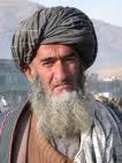
Afghan headgear is one of the most identifying aspects of their clothing.
Turbans are worn by Afghan men, and the man is considered more fashionable when
the turban is made of more cloth. It can be from three to six meters long, and
is usually made from white cotton. Some Pashtun men wear silk turbans of grays,
browns, and pinks, or black turbans. There are also caps worn under turbans,
called kolāh or kōlay, that are decorated according to different
reasons. Caps with silk embroidery and that are cylindrical in shape are worn by
the Tajik and Uzbek, fitted skullcaps made of felt, or barrak, and
quilted chintz are worn by the Hazāra, and caps of embroidered gold and silver
thread, or golābatūnī,in cylindrical shapes are worn by the Pashtun of
Qandahār. These people also wear foldable caps with colored glass beads. Caps
worn by the Baluch have round mirror fragments, called šīša, and the
Šīnwārī eastern Pashtun where conical caps of wheat straw, called druzaw ḵōlay, and small round felt caps. Turkmen wear tīlpak,or sheepskin hats, the Kirghiz where round fir-trimmed hats and quilted hats with earflaps, and the men from Nūrestān where flat-topped woolen caps with rolled rims, called pakōl generally; śukokuṛ in Kāmvīrī. The qarakolī, cylindrical hat made from Persian lamb, used to distinguish educated urban men, but it is currently out of style (Dupree).
Turbans are worn by Afghan men, and the man is considered more fashionable when
the turban is made of more cloth. It can be from three to six meters long, and
is usually made from white cotton. Some Pashtun men wear silk turbans of grays,
browns, and pinks, or black turbans. There are also caps worn under turbans,
called kolāh or kōlay, that are decorated according to different
reasons. Caps with silk embroidery and that are cylindrical in shape are worn by
the Tajik and Uzbek, fitted skullcaps made of felt, or barrak, and
quilted chintz are worn by the Hazāra, and caps of embroidered gold and silver
thread, or golābatūnī,in cylindrical shapes are worn by the Pashtun of
Qandahār. These people also wear foldable caps with colored glass beads. Caps
worn by the Baluch have round mirror fragments, called šīša, and the
Šīnwārī eastern Pashtun where conical caps of wheat straw, called druzaw ḵōlay, and small round felt caps. Turkmen wear tīlpak,or sheepskin hats, the Kirghiz where round fir-trimmed hats and quilted hats with earflaps, and the men from Nūrestān where flat-topped woolen caps with rolled rims, called pakōl generally; śukokuṛ in Kāmvīrī. The qarakolī, cylindrical hat made from Persian lamb, used to distinguish educated urban men, but it is currently out of style (Dupree).
Men's Clothing
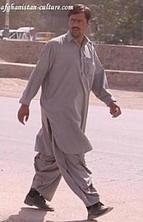
Men’s clothing is similar to women and children’s in Afghanistan. They wear loose drawstring pants and long sleeved shirts worn outside the pants, or tanbān, ezār in Persian and partōg in Pashto. The shirts, called perānor korta, are collarless and buttoned at one shoulder, and they go down to knee, mid-calf, or lower. The Qandahāri shirt fronts are beautifully embroidered, called gaṛa or ganḍa. Men’s waistcoats, or waskat, are made out of black or red velvet and
decorated with gold braid or embroidery, and are very popular. Quite a few men like western vests, coats, and jackets which they purchase, rather than make, from bāzārs. Outer-wear varies depending on the region, but some types include pōstīn, which are dressed-sheepskin coats with fleece inside and sleeves, or pōstīṇča, which is the same thing but without sleeves. Around the Pashtun area near Ḡaznī, these coats are embroidered. In the north, people wear full-length collarless robes with long sleeves and colored stripes – these are jīlak (quilted) and čapan (single-weight). Some are worn with a sash and make of silk and handwoven cotton, and these are karbās. The gopīča is an Uzbek padded coat that slips over the head and fastens at one side of the neck, usually made our of dark-red or brown cotton. Kūsay are short-sleeved felt coats with elaborate embroidery worn by the Pashtun in Paktīā. Čādar are woolen shawls worn in winter (Dupree).
decorated with gold braid or embroidery, and are very popular. Quite a few men like western vests, coats, and jackets which they purchase, rather than make, from bāzārs. Outer-wear varies depending on the region, but some types include pōstīn, which are dressed-sheepskin coats with fleece inside and sleeves, or pōstīṇča, which is the same thing but without sleeves. Around the Pashtun area near Ḡaznī, these coats are embroidered. In the north, people wear full-length collarless robes with long sleeves and colored stripes – these are jīlak (quilted) and čapan (single-weight). Some are worn with a sash and make of silk and handwoven cotton, and these are karbās. The gopīča is an Uzbek padded coat that slips over the head and fastens at one side of the neck, usually made our of dark-red or brown cotton. Kūsay are short-sleeved felt coats with elaborate embroidery worn by the Pashtun in Paktīā. Čādar are woolen shawls worn in winter (Dupree).
Women's Headgear
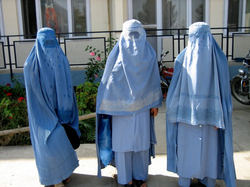
Women’s head gear is also very iconic of Afghanistan. All women are supposed to cover their heads in Islam, so the majority of women, especially those in the rural communities, wear čādar, which are small or large rectangular headscarves – they sometimes also wear the small hats similar to the men’s. The čādar is usually made of soft cotton and a solid color. The Pashtun tribeswomen wear ankle-length čādar with gold embroidery. There is also the čādarī, which is a cap with pleated colored silk or rayon falling from it, which completely covers the woman. The čādarī has a crocheted grid over the eyes only. The bōqrā and paranjī are other styles of the čādarī. The čādarī are worn more in urban areas. The Turkmen women wear bojmāq, which are tall, highly decorated headdresses that represent different stages of life. Uzbek bridal headdress are similar to these, but not as ornamented. They even decorate baby bonnets with feathers, beads, and more (Dupree).
Women's Clothing
Women’s clothing is similar to men’s, but the details are very important to them, including length, cut, drape, fullness, sleeves, fabrics, etc. Women usually make their clothing at home instead of buying it. The dresses worn among the Pashtun have high-wasted bodices, flaring elbow-length cuffs, and deep borders on the hems that are all covered with embroidery. The wealthier nomads, the māldār, prefer to use red, green, and royal-purple velvet (Dupree). The burqa is the Arabic word for the whole covering of a woman, including the head piece, veil, and cloak. Women were required by the Taliban to wear burqas, specifically čādarī (also known as chadri), but they are less popular in cities now that the Taliban is defeated (Rantanen). In Kabul by the 1950’s women were allowed to be unveiled, along with the change of education to co-ed. This simple change in clothing contributed to a movement for women’s rights. In the 1960’s, ‘70’s, and ‘80’s women worked with men, drove cars, went out at night, and the dowry was outlawed. However, in the ‘90’s, women had to wear burqas again do to danger of rival ethnic attacks. This is why the Taliban outlawed unveiled women and their participation on many aspects of public life. By the mid 2000’s women were appearing unveiled only on university campus, and the gender policies are continuing to go back and forth still (Zulfacar).
Nūrestāni Style
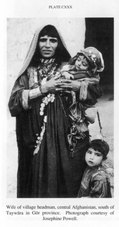
One of the most distinctive styles of dress for men and women is the Nūrestāni style. Women wear long, full skirts or robes, called bāźü, with leggings underneath. The bāźü are tied at the waste with woven belts called niśte and embellished on the back and shoulders with red and black appliques that are unique to their region. The men wear white wool pants that come to the calf, called viṭ, over long black leggings (pātaw). These pātaw are the only leg coverings made in Afghanistan besides the knitted stockings from the Hazāra. The Nūrestāni men also wear silver-studded belts, called mālāa niśte, that are for holding daggers, or kātra (Dupree).
Western Clothing
Western style clothing has been popular in the urban communities among the educated upper classes. These clothing styles were introduced in the early 1900’s as a government attempt to bring the country up to date. This was especially important to women because western dress represented freedom. During Soviet occupation after the leftist revolution in the late twentieth century, western style was very popular in Kabul. However, refugees in Pakistan from Afghanistan wear traditional clothing to represent their commitment to their country’s culture and Islam (Dupree).
Footwear
The footwear in Afghanistan varies almost as much as the clothing. There are many types of a leather sandal, called čaplī or čaplay, whose sole is made from rubber from old tires. Straw sandals, or mazarī čaplay, are worn in Paktīā. There are ankle high moccasins called vācó from Nūrestān, and knee high leather boots, called čamūs, with high heels and the soft-soled māsī worn by Turkic speakers. People also wear stout rubber over-shoes on their own, called kalawš (Dupree).
Jewelry
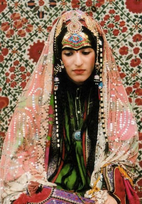
Jewelry is more important to women than men, and it is usually mostly silver. They also wear beads, coins, disks, and amulets, or taʿwīḏ, sewn onto their clothing. In eastern Pashtun, the silver decoration is combined with mirror work, gold and silver braid, and creative beading (Dupree).
Works Cited
Dupree, Nancy H. "Clothing xiii. Clothing in Afghanistan." Encyclopaedia Iranica. Encyclopaedia Iranica, n.d. Web. 27 Sept. 2011. <http://www.iranicaonline.org/articles/clothing-xiii>.
Rantanen, Pekka. "Non-documentary burqa pictures on the intenet: Ambivalence and the politics of representation." EBSCO Host. International Journal of Cultural Studies, Sept. 2005. EBSCO. Web. 23 Sept. 2011. <http://web.ebscohost.com/ehost /detail?vid=3&hid=122&sid=171d7078-3c0a-4d7a-a07a-53c24c9373c4%40sessionmgr111& bdata=JnNpdGU9ZWhvc3QtbGl2ZQ%3d%3d#db=aph&AN=18792048>.
Zulfacar, Maliha. "The pendulum of gender politics in Afghanistan." EBSCO Host. Cetral Asian Survey, Mar. 2006. EBSCO. Web. 23 Sept. 2011. <http://web.ebscohost.com/ehost/detail?vid=6&hid=122&sid=171d7078-3c0a-4d7a-a07a- 53c24c9373c4%40sessionmgr111&bdata=JnNpdGU9ZWhvc3QtbGl2ZQ%3d%3d#db=aph&AN=22909437>.
Images
“Afghan Bride.” Style Guru, n.d. JPEG file <styleguru.com>
“Afghanistan Clothing for Men.” Afghanistan Culture, n.d. JPEG file < afghanistan-culture.com>
“Afghanistan Turban.” Somaliland Info, n.d. JPEG file. < http://www.somalilandinfo.com/home2/2011/08/09/hamid-karzai- is-banning-wearing-afghan-turbans/>.
“Burqa.” Operator Chan, n.d. JPEG file <operatorchan.org>
Powell, Josephine. “Wife of Village Headman.” Iranica, n.d. JPEG file <iranicaonline.org>
Rantanen, Pekka. "Non-documentary burqa pictures on the intenet: Ambivalence and the politics of representation." EBSCO Host. International Journal of Cultural Studies, Sept. 2005. EBSCO. Web. 23 Sept. 2011. <http://web.ebscohost.com/ehost /detail?vid=3&hid=122&sid=171d7078-3c0a-4d7a-a07a-53c24c9373c4%40sessionmgr111& bdata=JnNpdGU9ZWhvc3QtbGl2ZQ%3d%3d#db=aph&AN=18792048>.
Zulfacar, Maliha. "The pendulum of gender politics in Afghanistan." EBSCO Host. Cetral Asian Survey, Mar. 2006. EBSCO. Web. 23 Sept. 2011. <http://web.ebscohost.com/ehost/detail?vid=6&hid=122&sid=171d7078-3c0a-4d7a-a07a- 53c24c9373c4%40sessionmgr111&bdata=JnNpdGU9ZWhvc3QtbGl2ZQ%3d%3d#db=aph&AN=22909437>.
Images
“Afghan Bride.” Style Guru, n.d. JPEG file <styleguru.com>
“Afghanistan Clothing for Men.” Afghanistan Culture, n.d. JPEG file < afghanistan-culture.com>
“Afghanistan Turban.” Somaliland Info, n.d. JPEG file. < http://www.somalilandinfo.com/home2/2011/08/09/hamid-karzai- is-banning-wearing-afghan-turbans/>.
“Burqa.” Operator Chan, n.d. JPEG file <operatorchan.org>
Powell, Josephine. “Wife of Village Headman.” Iranica, n.d. JPEG file <iranicaonline.org>
